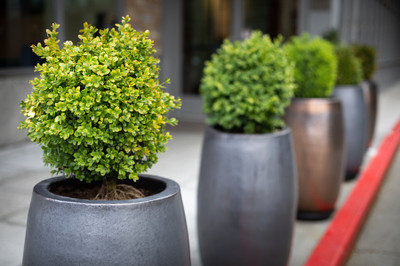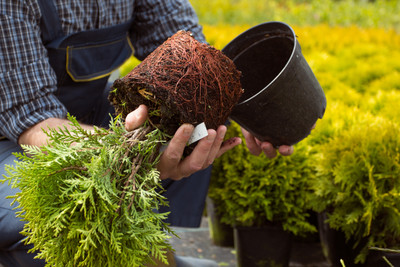Stylish Outdoor Dining Area Ideas
Posted by Jason Wyrwicz on May 8th 2025

Dining under the open sky, with a gentle breeze and the soft sound of nature in the background, is one of life’s simplest pleasures.
But setting up a comfortable outdoor dining space isn’t just about placing a table and chairs on a patio. It involves a thoughtful blend of style and functionality—everything from the flow of the furniture layout to the impact of planters and greenery.
Whether you have a small patio, a sprawling deck, or a rooftop terrace, a well-designed outdoor dining area invites you to step outside and make the most of your surroundings. Planters, in particular, can lend structure and a sense of privacy, enhancing the overall look without feeling overly rigid.
In the sections that follow, we’ll explore a range of outdoor dining area ideas—from choosing the right furniture setup to perfecting your lighting, shade, and color palette—so you can craft the ideal al fresco setting.
Choose the Right Dining Setup for Your Space
Dining Table Styles

When planning your outdoor dining area design, you’ll want a table that not only looks good but also suits the scale of your space. For those who love the warmth of a rustic setting, a long farmhouse table brings the charm of country living into your backyard. It’s perfect for big families, social gatherings, or weekend barbecues, and it pairs beautifully with bench-style seating.
If you’re working with limited square footage—say, a petite patio or balcony—a café bistro set might be your best friend. Bistro sets usually include a small table and a pair of chairs, offering an intimate spot for two people to chat or enjoy breakfast.
For homeowners who want something more versatile, a round table is often the most space-efficient solution: it encourages conversation, fits neatly into corners, and works well in both modern and traditional spaces.
Seating: Benches vs. Chairs

Choosing between benches and chairs often comes down to personal preference and the vibe you’d like to create. Benches can seat more people in a pinch, making them excellent for entertaining.
On the other hand, chairs with back support might be more comfortable for leisurely lunches.
- Whichever option you prefer, consider adding cushions made from weather-resistant materials to boost comfort. Look for fabrics that stand up to sun exposure and moisture, ensuring your furniture stays in good shape.
For smaller patios, foldable chairs or stackable seating can be game-changers. You can store them easily when not in use, freeing up space for other activities.
Layout Considerations

Layout plays a crucial role in how guests will move and mingle. In cramped or narrow spaces, push your table to one side to maintain a clear walking path.
On larger decks or lawns, consider creating multiple zones—such as a dining area, a lounge area with outdoor sofas, and perhaps even a grilling or bar station.
This zoned approach promotes conversation and helps everyone stay connected during gatherings.
Frame Your Space with Planters

Why Planters Matter?
Planters are often overlooked when designing an outdoor dining space, yet they can be the element that pulls everything together.
Tall planters, especially in fiberglass, are a sleek way to define the perimeter of your seating area or create a secluded nook within a larger yard.
The beauty of fiberglass lies in its durability and lightweight composition—it stands up to different climates while being easy to move if you want to refresh the layout.
Layer Heights for Impact
Strategically layering planters of varying heights is one of the most effective outdoor dining decor ideas.
Tall planters anchor the back, providing a sense of enclosure, while medium planters can ring the edges of your dining zone, adding depth and dimension.
Clusters of pots with ornamental grasses, olive trees, or lush flowering plants soften the look and bring in natural textures.
Planter Benefits
Fiberglass planters have gained favor among homeowners and designers for a simple reason: they offer style without sacrificing practicality.
Below are the key advantages that make these planters an excellent fit for modern outdoor dining setups.
Lighting That Sets the Mood
String Lights for Ambiance

When the sun goes down, the right lighting can transform your outdoor dining area from a simple seating arrangement into a warm, inviting retreat. Bistro or café string lights hung overhead are a timeless choice for ambiance.
They cast a gentle glow that’s perfect for evening meals and late-night chats. Plus, they’re relatively easy to install—drape them between pergolas, tree branches, or porch columns.
Lanterns, Solar Lights, and Candles

Lanterns offer both form and function. They look charming, placed on tables or hung along a railing. Solar-powered lanterns minimize cords and use renewable energy, so you don’t have to fuss with outlets.
Candles, meanwhile, create a soft glow. Tuck votives or pillar candles inside glass hurricanes to protect the flame from wind and add a romantic flicker that works well for date nights or special gatherings.
Uplighting & Planter Integration

For a contemporary twist, use spotlights at the base of tall planters. These beams of light can highlight ornamental foliage or architectural elements around your dining area.
You could also place small, raised planters around the perimeter, each housing a low-voltage uplight to direct attention toward your plants and seating arrangement.
This combination of planters and illumination not only helps define the space but also lends a dramatic edge once night falls.
Table of Lighting Types
- String Lights: Pros—easy to install, budget-friendly; Cons—limited brightness.
- Lanterns: Pros—portable, decorative; Cons—may need frequent cleaning or refilling (if using oil or candles).
- Pathway Lights: Pros—safety and wayfinding; Cons—less ambient, more functional.
- Uplights: Pros—great for accentuating features; Cons—may require wiring or professional installation.
Lighting decisions often come down to personal taste and budget, but layering multiple sources of light ensures your outdoor eating area remains functional and enjoyable well into the evening hours.
Add Shade and Shelter
Umbrellas and Pergolas

Shade is a necessity in many regions, particularly during warmer months. A simple umbrella centered over your dining table is often the easiest solution. Look for umbrellas with tilt capabilities so you can adjust coverage as the sun moves.
If you’re seeking something more permanent, a pergola can define your outdoor dining space while providing partial shade. You can even attach retractable canopies or incorporate climbing vines for additional sun protection and a more organic feel.
Using Planters for Natural Shade

A creative outdoor garden restaurant design approach is to place tall fiberglass planters around the dining area and let climbing plants do the work. Imagine lush vines of jasmine or ivy draping over a pergola’s beams—it’s not just functional but also visually striking.
Layer Textures and Colors

Mix Materials
Texture breathes life into any outdoor dining area design. Pair a sleek metal table with wooden chairs, or opt for a weathered teak table under industrial-style pendant lights.
You might add stone elements or even a concrete bench for a modern edge. Fiberglass planters, available in finishes that resemble natural stone or ceramic, can tie the space together by adding another textural layer.
Soft Furnishings
Cushions, throws, and outdoor rugs soften any hard surfaces, making the space more welcoming. Look for fabrics designed specifically for outdoor conditions, which are typically resistant to fading, moisture, and mildew.
Opt for pieces that align with your color scheme—use bright hues if you want a bold statement, or stick to muted earth tones for a more subdued, natural aesthetic.
Plant Color Anchors
Plants also play a part in your color palette. If you gravitate toward a Mediterranean feel, potted lavender or rosemary in neutral-toned planters adds pops of green and purple.
For a tropical motif, consider vibrant flowering varieties. The key is coherence: match or complement the colors of your planters with shades in your cushions or tableware, pulling the look together without feeling too matchy-matchy.
Small Space Solutions

Compact Furniture
Designing an inviting outdoor dining space when you have limited real estate can be challenging, but it’s far from impossible. Wall-mounted or drop-leaf tables that fold away when not in use are particularly handy.
Folding chairs or stacking stools can be tucked into a corner or closet, ensuring you still have room to move around when the table isn’t in use.
Smart Planter Placement
In narrow balconies or compact patios, planters often compete for space with seating. One solution is to use fiberglass planters as slim dividers, defining your dining area without overcrowding the zone.
Vertical gardening—such as stacking tiered planters against a wall—lets you enjoy greenery without sacrificing floorspace. Herbs in small pots can also hang along the balcony railing, simultaneously adding fragrance and convenience for outdoor cooking.
By blending functional items (like foldable tables) with aesthetic touches (a few well-placed plants), you can create an outdoor eating area that feels cozy, not cramped.
Entertain with Extras

Bar Cart or Drink Station
Nothing elevates an outdoor gathering faster than the convenience of a dedicated drink station.
A simple bar cart—stocked with glasses, ice, mixers, and even a decorative garnish—lets guests help themselves, freeing them up to mingle.
Some outdoor dining tables come with built-in coolers in the center—ideal for keeping beverages chilled on warm days.
Tech & Warmth
If you’d like to host dinner parties well into the night, a fire pit or patio heater can extend the season.
Incorporating smart lighting or outdoor speakers can also liven up the atmosphere. Imagine subtle background music playing through weatherproof speakers as you enjoy a sunset meal with friends.
Herbs in Planters
Fiberglass planters don’t have to be reserved for ornamental plants. You can also use them to grow practical herbs like rosemary, basil, or mint right next to your dining area. It’s convenient for garnishing cocktails, seasoning food, or simply enjoying their fresh aroma.
Plant Ideas to Match Your Vibe

Mediterranean Look
Dreaming of coastal sunsets? Incorporate hardy plants like olive trees or lavender in sleek, neutral fiberglass planters. Olive trees add a sculptural element, while lavender’s fragrance can set a tranquil tone.
Tropical Flair
Palm varieties, birds of paradise, and hibiscus bring a lush, exotic feel—especially if you’re aiming for a beachy or resort-inspired environment. They thrive in warm, humid climates and deliver vibrant visual impact.
Minimalist Approach
If you prefer a subdued, modern style, choose succulents or ornamental grasses. Fewer frills, more structured silhouettes.
Stick to simple planter shapes—cubes, cylinders, or tall rectangular profiles—for a balanced, uncluttered aesthetic.
Luxe Style
Nothing says opulence like trimmed boxwood topiaries or potted hydrangeas. Pair them with refined stone-like fiberglass planters in grey or black for a look that’s classic and effortlessly elegant.
Potted citrus trees also lend an upscale feel, evoking images of European courtyards.
Conclusion
The right combination of dining furniture, thoughtfully placed planters, inviting lighting, and shelter from the elements can make all the difference between a lackluster patio and a destination-worthy outdoor eating area.
Fiberglass planters, in particular, offer a low-maintenance way to breathe life into your space. They’re resilient, modern, and versatile, making them a wise investment for a variety of styles—be it a cozy farmhouse, sleek industrial, or breezy Mediterranean.
By embracing thoughtful design choices—like layering textures, providing shade, and integrating greenery—you’ll craft a space that you’ll look forward to enjoying day after day, all season long.






